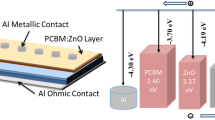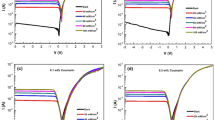Abstract
In this study, three different poly(vinyl alcohol) (PVA) films doped with weight percentages of 0.05, 0.10 and 0.20 coumarin were coated on p-Si wafer via spin-coating method for the purpose of investigating the interaction of coumarin dopant with polymer host at molecular level. Therefore, metal–polymer–semiconductor (MPS) structures were formed and their current–voltage (I–V) and admittance measurements were taken to compare the main electrical parameters of the MPS structures with different film thicknesses. The values of ideality factor (n), barrier height (Φb), rectification ratio (RR = IF/IR), series resistance (Rs) and energy-dependent profiles of surface states (Nss) were calculated using the forward bias I–V data. There exists increasing trend for Nss values from mid-gap energy of Si toward the bottom of conductance band. The highest values of RR and photosensitivity (Iphoto/Idark) were found as 4.62 × 104 at ± 4 V for the MPS structure with 0.10 wt% coumarin doping level, respectively. The photoresponse of the structures was also analyzed using \(I_{\text{ph}} = AP^{m}\) relation, and the value of m was obtained from the slope of ln(Iph)–Ln(P) plot for each diode as 1.48, 1.27 and 1.57, respectively. Experimental results suggest that 0.10% coumarin-doped PVA caused MPS structure to reveal better performance considering higher RR and lowest Nss, and so it can be considered as an alternative interfacial layer material for replacing traditional insulators.













Similar content being viewed by others
References
Sze SM (1995) Physics of semiconductor devices physics of semiconductor devices, 2nd edn. Wiley, New York
Rhoderick EH, Williams RH (1988) Metal-semiconductor contacts, 2nd edn. Clarendon Press, Oxford
Wieder HH (1982) MOS (metal oxide semiconductors) physics and technology by E. H. Nicollian and J. R. Brews. J Vac Sci Technol 21:1048–1049. https://doi.org/10.1116/1.571867
Tanrıkulu EE, Demirezen S, Altındal Ş, Uslu İ (2018) On the anomalous peak and negative capacitance in the capacitance–voltage (C–V) plots of Al/(%7 Zn-PVA)/p-Si (MPS) structure. J Mater Sci Mater Electron 29:2890–2898. https://doi.org/10.1007/s10854-017-8219-1
Demirezen S, Orak İ, Azizian-Kalandaragh Y, Altındal Ş (2017) Series resistance and interface states effects on the C–V and G/w–V characteristics in Au/(Co3O4-doped PVA)/n-Si structures at room temperature. J Mater Sci Mater Electron 28:12967–12976. https://doi.org/10.1007/s10854-017-7128-7
Altındal Yerişkin S, Balbaşı M, Demirezen S (2017) Temperature and voltage dependence of barrier height and ideality factor in Au/0.07 graphene-doped PVA/n-Si structures. Indian J Phys 91:421–430. https://doi.org/10.1007/s12648-016-0949-z
Tecimer H, Tan SO, Altindal S (2018) Frequency-dependent admittance analysis of the metal-semiconductor structure with an interlayer of Zn-doped organic polymer nanocomposites. IEEE Trans Electron Devices 65:231–236. https://doi.org/10.1109/TED.2017.2778023
Çiçek O, Uslu Tecimer H, Tan SO et al (2017) Synthesis and characterization of pure and graphene (Gr)-doped organic/polymer nanocomposites to investigate the electrical and photoconductivity properties of Au/n-GaAs structures. Compos B Eng 113:14–23. https://doi.org/10.1016/j.compositesb.2017.01.012
Tataroğlu A, Al-Ghamdi AA, El-Tantawy F et al (2016) Analysis of interface states of FeO–Al2O3 spinel composite film/p-Si diode by conductance technique. Appl Phys A 122:220. https://doi.org/10.1007/s00339-016-9782-7
Wang B, Guan X, Hu Y, Su Z (2007) Preparation and fluorescent properties of poly(vinyl alcohol) bearing coumarin. Polym Adv Technol 18:529–534. https://doi.org/10.1002/pat.911
Ghouili A, Dusek M, Petricek V et al (2014) Synthesis, crystal structure and spectral characteristics of highly fluorescent chalcone-based coumarin in solution and in polymer matrix. J Phys Chem Solids 75:188–193. https://doi.org/10.1016/j.jpcs.2013.09.011
Demirezen S, Kaya A, Vural Ö, Altındal Ş (2015) The effect of Mo-doped PVC + TCNQ interfacial layer on the electrical properties of Au/PVC + TCNQ/p-Si structures at room temperature. Mater Sci Semicond Process 33:140–148. https://doi.org/10.1016/j.mssp.2015.01.050
Yerişkin SA, Balbaşı M, Orak İ (2017) The effects of (graphene doped-PVA) interlayer on the determinative electrical parameters of the Au/n-Si (MS) structures at room temperature. J Mater Sci Mater Electron 28:14040–14048. https://doi.org/10.1007/s10854-017-7255-1
Tecimer H, Tunç T, Altındal Ş (2018) Investigation of photovoltaic effect on electric and dielectric properties of Au/n-Si Schottky barrier diodes with nickel (Ni)–zinc (Zn) doped organic interface layer. J Mater Sci Mater Electron 29:3790–3799. https://doi.org/10.1007/s10854-017-8314-3
Sharma M, Tripathi SK (2013) Analysis of interface states and series resistance for Al/PVA:n-CdS nanocomposite metal–semiconductor and metal–insulator–semiconductor diode structures. Appl Phys A 113:491–499. https://doi.org/10.1007/s00339-013-7552-3
Çetinkaya HG, Kaya A, Altındal Ş, Koçyiğit S (2015) Electrical and dielectric properties of Au/1% graphene (GP) + Ca 1.9 Pr 0.1 Co 4 O x doped poly(vinyl alcohol)/n-Si structures as function of temperature and voltage. Can J Phys 93:1213–1220. https://doi.org/10.1139/cjp-2014-0628
Tozlu C, Mutlu A (2016) Poly(melamine-co-formaldehyde) methylated effect on the interface states of metal/polymer/p-Si Schottky barrier diode. Synth Met 211:99–106. https://doi.org/10.1016/j.synthmet.2015.11.023
Wan W, Bannerman AD, Yang L, Mak H (2014) Poly(vinyl alcohol) cryogels for biomedical applications. In: Okay O (ed) Polymeric cryogels, Advances in polymer science, vol 263. Springer, Cham. https://doi.org/10.1007/978-3-319-05846-7_8
Reddy VR (2014) Electrical properties of Au/polyvinylidene fluoride/n-InP Schottky diode with polymer interlayer. Thin Solid Films 556:300–306. https://doi.org/10.1016/j.tsf.2014.01.036
Reddy MSP, Kang H-S, Lee J-H et al (2014) Electrical properties and the role of inhomogeneities at the polyvinyl alcohol/n-inp schottky barrier interface. J Appl Polym Sci. https://doi.org/10.1002/app.39773
Zhao X, Dang Y, Deng J, Zhang J (2014) Photoinduced shape fixity and thermal-induced shape recovery properties based on polyvinyl alcohol bearing coumarin. Colloid Polym Sci 292:85–95. https://doi.org/10.1007/s00396-013-3057-z
Bisen R, Tripathi J, Sharma A et al (2018) Optical behaviour of coumarin dye in PVA and PMMA film matrices. Vacuum 152:65–69. https://doi.org/10.1016/j.vacuum.2018.03.004
Liu X, Cole JM, Waddell PG et al (2012) Molecular origins of optoelectronic properties in coumarin dyes: toward designer solar cell and laser applications. J Phys Chem A 116:727–737. https://doi.org/10.1021/jp209925y
Wang Z-S, Hara K, Dan-oh Y et al (2005) Photophysical and (photo)electrochemical properties of a coumarin dye. J Phys Chem B 109:3907–3914. https://doi.org/10.1021/jp044851v
Chen Y, Kang KS, Han KJ et al (2009) Enhanced optical and electrical properties of PEDOT: pSS films by the addition of MWCNT-sorbitol. Synth Met 159:1701–1704. https://doi.org/10.1016/j.synthmet.2009.05.009
Dhar A, Kumar NS, Paul PK et al (2018) Influence of tagging thiophene bridge unit on optical and electrochemical properties of coumarin based dyes for DSSCs with theoretical insight. Org Electron 53:280–286. https://doi.org/10.1016/j.orgel.2017.12.007
Mir FA, Shakeel u Rehman Asokan K et al (2014) Optical, DC and AC electrical investigations of 4-hydroxy coumarin molecule as an organic Schottky diode. J Mater Sci Mater Electron 25:1258–1263. https://doi.org/10.1007/s10854-014-1718-4
Raikar US, Renuka CG, Nadaf YF, Mulimani BG (2006) Steady-state, time-resolved fluorescence polarization behaviour and determination of dipole moments of coumarin laser dye. J Mol Struct 787:127–130. https://doi.org/10.1016/j.molstruc.2005.10.040
Rose A (1963) Concepts in photoconductivity and allied problems. Interscience Publishers, New York
Mekki A, Ocaya RO, Dere A et al (2016) New photodiodes based graphene-organic semiconductor hybrid materials. Synth Met 213:47–56. https://doi.org/10.1016/j.synthmet.2015.12.026
Cheung SK, Cheung NW (1986) Extraction of Schottky diode parameters from forward current–voltage characteristics. Appl Phys Lett 49:85–87. https://doi.org/10.1063/1.97359
Card HC, Rhoderick EH (1971) Studies of tunnel MOS diodes I. Interface effects in silicon Schottky diodes. J Phys D Appl Phys 4:319. https://doi.org/10.1088/0022-3727/4/10/319
Demirezen S, Altındal Ş, Uslu İ (2013) Two diodes model and illumination effect on the forward and reverse bias I–V and C–V characteristics of Au/PVA (Bi-doped)/n-Si photodiode at room temperature. Curr Appl Phys 13:53–59. https://doi.org/10.1016/j.cap.2012.06.009
Bube RH (1960) Photoconductivity of solids, 1st edn. Wiley, New York
Zhang M, Xu Y, Lv J et al (2014) Capability of coupled CdSe/TiO2 heterogeneous structure for photocatalytic degradation and photoconductivity. Nanoscale Res Lett 9:636. https://doi.org/10.1186/1556-276X-9-636
Moore J, Thompson C (2013) A phenomenological model for the photocurrent transient relaxation observed in ZnO-based photodetector devices. Sensors 13:9921–9940. https://doi.org/10.3390/s130809921
Khan W, Kim S-D (2017) Ultra-violet photo-response characteristics of p-Si/i-SiO2/n-ZnO heterojunctions based on hydrothermal ZnO nanorods. Mater Sci Semicond Process 66:232–240. https://doi.org/10.1016/j.mssp.2017.04.031
Yakuphanoglu F, Mensah-Darkwa K, Al-Ghamdi AA et al (2016) Novel organic doped inorganic photosensors. Microelectron Eng 160:27–33. https://doi.org/10.1016/j.mee.2016.03.001
Acar FZ, Buyukbas-Ulusan A, Tataroglu A (2018) Analysis of interface states in Au/ZnO/p-InP (MOS) structure. J Mater Sci Mater Electron 29:12553–12560. https://doi.org/10.1007/s10854-018-9371-y
Doğan H, Yıldırım N, Orak İ et al (2015) Capacitance-conductance-frequency characteristics of Au/Ni/n-GaN/undoped GaN structures. Phys B Condens Matter 457:48–53. https://doi.org/10.1016/j.physb.2014.09.033
Wageh S, Farooq WA, Tataroğlu A et al (2017) A photodiode based on PbS nanocrystallites for FYTRONIX solar panel automatic tracking controller. Phys B Condens Matter 527:44–51. https://doi.org/10.1016/j.physb.2017.09.114
Acknowledgements
This work is supported by Amasya University BAP research Project with FMB-BAP 17-0292 Number and Gazi University Scientific Research Projects (Project Numbers: GU-BAP.05/2018-10 and GU-BAP.06/2018-05).
Author information
Authors and Affiliations
Corresponding author
Additional information
Publisher's Note
Springer Nature remains neutral with regard to jurisdictional claims in published maps and institutional affiliations.
Rights and permissions
About this article
Cite this article
Demirezen, S., Altındal Yerişkin, S. A detailed comparative study on electrical and photovoltaic characteristics of Al/p-Si photodiodes with coumarin-doped PVA interfacial layer: the effect of doping concentration. Polym. Bull. 77, 49–71 (2020). https://doi.org/10.1007/s00289-019-02704-3
Received:
Revised:
Accepted:
Published:
Issue Date:
DOI: https://doi.org/10.1007/s00289-019-02704-3




